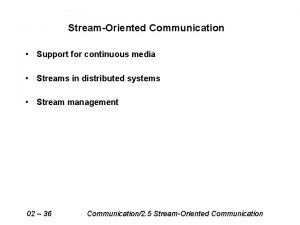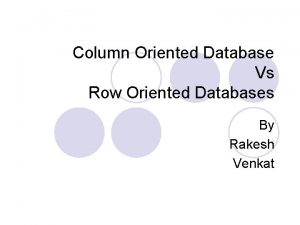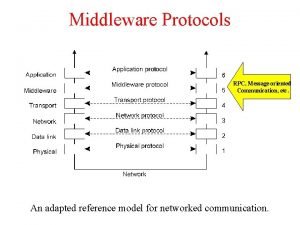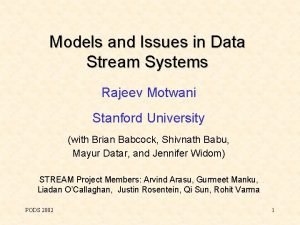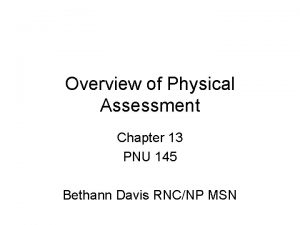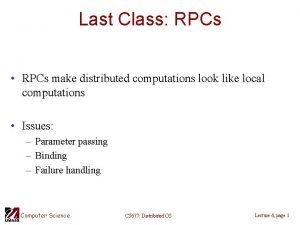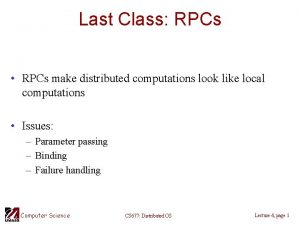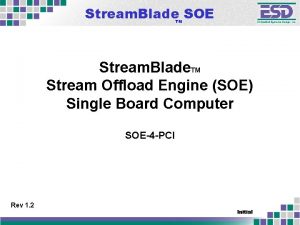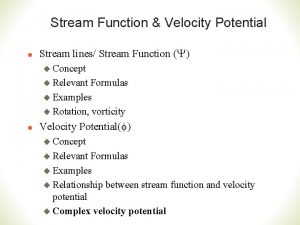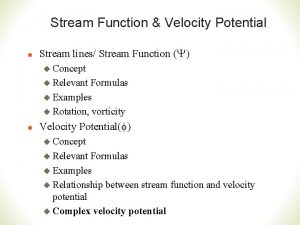Communication Chapter 2 Stream Oriented Communication RPCs and
















- Slides: 16

Communication Chapter 2

Stream –Oriented Communication • RPCs and Messages focus on exchanging independent and complete units of information • Communication timing does not affect correctness – It may however affect the performance • Timing is crucial for certain applications • Continuous media – Temporal relationships are critical to correctness • Discrete media – Timing is not critical to correctness

Data Streams • • Sequence of data units – E. g. Unix Pipes, TCP/IP Three transmission modes Asynchronous – Orderly transmission of data units Synchronous – Maximum end-to-end delay is specified • Isynchronous – Data units are transferred on time • Simple and Complex streams

Data Stream Architecture

Streams and Quality of Service Properties for Quality of Service: • The required bit rate at which data should be transported. • The maximum delay until a session has been set up • The maximum end-to-end delay. • The maximum delay variance (jitter) • The maximum round-trip delay.

Network Level Solutions • Differentiated Services • Expedited forwarding • Assured forwarding

Buffering to Reduce Jitter

Handling Packet Loss • Forward error correction codes • Interleaving

Interleaving to Handle Packet Loss

Synchronization Mechanisms (1) Figure 4 -29. The principle of explicit synchronization on the level data units.

Synchronization Mechanisms (2) Figure 4 -30. The principle of synchronization as supported by high-level interfaces.

Multicast Communication • Sending data to multiple recipients • Important for several distributed applications • IP-level multicasting • Setting up communication path is complex • Most ISPs do not support multicasting • Next-best alternative – Supporting multicast at the middleware level • Also known as application-level multicasting or overlaybased multicasting

Application-Level Multicasting • Multicast groups • Nodes of a multicast group organize into an overlay • Collaboratively disseminate data • Tree-based overlays • Simple and (relatively) more efficient • Susceptible to node and link failures • Mesh-based overlays • Provides better failure resilience • Scribe system

Performance Issues with Overlay-based Multicast

Metrics for Application-level Multicast • Link stress • Stretch • Tree cost

Epidemic-style Communication • • • Low overhead techniques to achieve multicasting Mimics how diseases spread Infected, susceptible and removed Anti-entropy technique Rumor spreading/gossiping
 Stream of communication
Stream of communication Stream oriented communication
Stream oriented communication Differentiate byte stream and character stream
Differentiate byte stream and character stream Consumer oriented vs trade-oriented sales promotion
Consumer oriented vs trade-oriented sales promotion Row oriented database
Row oriented database Chapter 11 section 2 stream and river deposits answer key
Chapter 11 section 2 stream and river deposits answer key Transient asynchronous communication
Transient asynchronous communication Message oriented communication
Message oriented communication Alaska
Alaska Models and issues in data stream systems
Models and issues in data stream systems Google drive
Google drive Emergency severity index
Emergency severity index What is performance-based assessment
What is performance-based assessment Performance assessment
Performance assessment How to assess alert and oriented
How to assess alert and oriented Interdepartmental flow graph
Interdepartmental flow graph Mental wellness activities
Mental wellness activities

